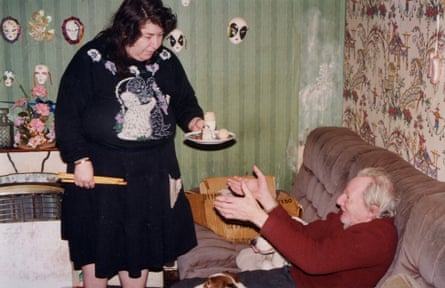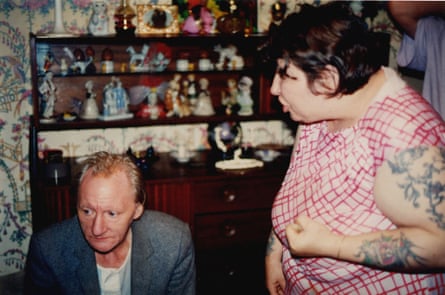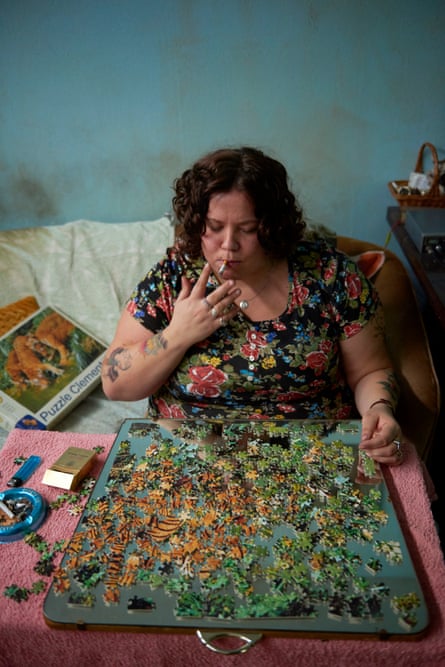It is just about 30 years since Richard Billingham picked up a camera and focused it on his alcoholic father, Ray, and his violent mother, Liz, and the Black Country council flat in which they lived. The pictures were intended as studies for paintings, but they took on a life of their own. A tutor on Billingham’s art degree course at Sunderland University came across the photographs in a plastic bag and Billingham ended up displaying them in all their flash-lit squalor: toothless and shirtless Ray cradling pop bottles of home brew; Liz, with her lavishly tattooed slabs of arms and vast floral print frocks, lost in her jigsaw puzzles or TV dinners. Taken together – “Ray’s a Laugh” is what Billingham called them – they seemed to provide a tragicomic through-the-keyhole of degraded post-Thatcherite Britain. Charles Saatchi included Billingham’s work in his 1997 Sensation show, alongside Damien Hirst’s shark and Tracey Emin’s tent.
Up until their premature deaths about a decade later, Billingham’s parents were mostly oblivious to the fact that they had generated a Turner prize nomination and global gallery fame. Billingham, however, who made his reputation as an art photographer on the rawness of those pictures, still felt he had unfinished business with them and with his adolescence. The result of that is Ray & Liz, a feature film he has written and directed that breathes claustrophobic life back into the original stills. In advance of release, it was shortlisted as an outstanding debut by Bafta and won the same category at the British independent film awards.
When he was setting out on the journey to make the film nearly three years ago, I spent a day with Billingham in the streets around Cradley Heath, west of Birmingham, where he grew up. We went up to the 14th floor of the refurbished former council block where the film was partly shot, with its carefully reconstructed 1970s peeling wallpaper and cigarette fug. At the time Billingham, along with his indefatigable producer Jacqui Davies, was launching a Kickstarter campaign to try to get the film off the ground. In the event, that campaign raised around £20,000 – plus a good deal of crucial awareness – toward a final begged and borrowed budget of £700,000 or so.
Billingham sat back then in a local cafe along with Deidre Kelly (“White Dee” of the Channel 4 documentary Benefits Street, who plays the older Liz in the film) and talked, in his halting, introspective way, about how he envisaged the movie as “a triptych”, of three intense fragments of childhood memory. That is how it has turned out. In the first part of the film we watch the older Ray (played by Patrick Romer) around the time Billingham made his photos, trapped in his bedroom, uncertain whether it is day or night, taking delivery of his plastic bottles of booze from a friend and slowly draining them, shouting out to the estranged Liz through the flat window.
The second part of the movie shifts back to when Billingham was about 10 and the family’s problems first spiralled after Ray lost his job as a factory machinist, and was conned out of his few grand of redundancy money. That memory involves an incident with Billingham’s childlike Uncle Lol, who is left in charge of Richard’s baby brother Jason, events that reveal Liz (played brilliantly as a younger woman by Ella Smith) in all her destructive rage.
The third part of the film focuses on the days before Jason, then seven or eight, was taken into foster care having spent a winter night in a garden shed far from home without Ray or Liz even noticing he was missing. Those shorthand descriptions are about all the action in Billingham’s film, but they do not begin to explain the layers of complex neglect (and frequent brutal human comedy) that are re-examined.
Billingham is, in person, both protective of that past and in some ways dismissive of its impacts. He has found ways, if not of processing it, then at least of framing it. He doesn’t blame his parents. Things could have turned out worse. As he said to me last week, looking back on it from his home in Swansea: “Jason often says to me now that, statistically, we should either be in prison or dead or homeless.”
That they aren’t, Billingham puts down to two things: elements of luck, and the fact that both he and his brother had “a love of nature” gleaned from watching David Attenborough documentaries and nurtured by annual childhood visits with Liz to Dudley Zoo, the highlight of his year. These outings, he believes, looking back, gave both him and his brother – who kept a box of pet snails under his bed – a way of seeing; a sense that the alcoholic chaos of family, caged and confined in its four walls, was not all the world.
In some ways, I suggested to Billingham, the finished film shifts the emotional heart of his pictures away from Ray and Liz and on to Jason, who experienced the worst fallout of their dereliction. Billingham depicts himself as numbed and helpless in protecting his brother. He smiles at my suggestion that the film is a fraternal love letter, but concedes that certainly those were the hardest parts for him to reimagine. Was a misplaced guilt at not having done more for his brother one of the motivations for needing to explain that past to himself again?
“Well, I had to look after myself, I suppose,” he says, after a pause. “And it’s the parents’ job, isn’t it, to look after the little one?”

He carefully reconstructed some of his brother’s memories – “how did that smell?”, “what did that look like to you?” – from a series of conversations with him. It was important to Billingham not to make it a film about his own experiences; he was afraid that might come over as self-indulgent. “Also, I am present in that I wrote it and directed it. I am there anyway.”
Jason still lives in Birmingham, where he works as a road-drainage surveyor, mapping motorway puddles (and “probably earning more than me,” Billingham says). I wondered what he had made of the film?
“I showed it to him on a link early on, and he said it was just how he remembered it. And there was a screening at the Midlands Arts Centre in Birmingham and he came with a dozen people, friends. Jason was laughing at it mostly. But the other people he came with were all in tears. He was very impressed that it was nominated in the Baftas, which was something my mother used to watch, I think, and he liked the fact that his story might be part of that, that something seemingly very small can become something important.”
Do they talk about Ray and Liz much?
“A little bit. But I probably only see him once or twice a year, and we never talk on the phone.”
Billingham has three children of his own, the oldest 12. He has settled in Swansea, his wife’s home city, though you get the sense he still carries those Black Country landscapes around with him in his head. His camera in Ray & Liz dwells with rapt attention on the few objects around which his childhood closeups cohered: the cassette recorder he used to make recordings both of the top 40 and of family rows (some of which he had kept and played back to the cast); the fake-flame electric fires he stared into.

There is an unfolding slowness to moments of childhood that the film captures exactly.
“Back then you might spend half an hour studying the back of a chair,” he says. “We shot it on film because we wanted to evoke that period. But I realise now that film renders that world better than digital. It’s great for capturing more natural materials – paper, wood, or cotton or wool.”
In recent months Billingham has been making photographs of rough sleepers near where he lives in Swansea. He finds that a digital camera is better for those portraits. “The homeless people I meet wear a lot of kind of mountain clothing and it is very synthetic,” he says. “They will have a Costa coffee cup, or a pre-packed sandwich that someone has given them, and the digital camera can render those modern surfaces and plastics really well. But the film camera is much better for older surfaces.”
What has led him to do the homeless pictures?
“I was interested by how the people on the streets have their own social life that runs in parallel to ours, but completely separate,” he says. “I get talking to them and you get a glimpse of the way they see us, from low down. Like a child’s perspective.”
Do they feel like kindred spirits, in that sense, observers of an estranging world?
He has been struck more by how easily, as a naturally shy person, he can fall into conversation with them. “It goes back to living in the tower block in my teenage years, when there was always the threat of sudden violence,” he says. “You had to talk to people in a certain way, empathetic, non-threatening, to avoid that, and I find myself doing that with the people I meet on the streets. They always say go ahead when I ask if I can make a picture of them.”

The other grim parallel he finds with the 1970s and 80s is the way that a kind of emblematic hopelessness has returned in those lives. “I watched that film I, Daniel Blake, that was a very good summary of it, it seemed to me. How Britain is today.” It reminded him in particular of how his parents were at the mercy of circumstances because they couldn’t fill in forms or make effective phone calls – Liz makes fruitless journeys in the film out to the payphone on the corner, with her pile of 2p pieces, to try to trace what happened to the money they lost. The internet has not made such a predicament any easier.
“The best thing you can do is talk to homeless people, to remind them they are not ignored,” Billingham says. “That or give them a cigarette. I watch them always scratching around in bins to make roll-ups. I watched one guy pulling stubs out of drains, then drying them out.”
Ray was himself a master of such scavenging. The kitchen window sill in the film contains a jar of nub-ends that Billingham’s father used to go out on night walks to find.
“He used to tell me that, as a teenager, you would stand next to someone who was smoking and wait, and when they dropped their fag you would pick it up,” he says. “I think he carried on from that.”
Those excursions were one of the few ways that Ray made sense of time. There is no shape to the days of the film, except that provided by the arrival of drink and the consequence of hangover. Billingham has watched some Samuel Beckett over the years, but he knew the atmosphere of those plays first-hand.
“Ray and Liz never woke up at a certain time or got up and had breakfast,” he says. “Their time was elliptical and messy, and I wanted the film to reflect that.”
Does he crave structure as a result in his own days?

“I have three kids so I don’t have much choice,” he says. “But I have a diary that I couldn’t live without. I think I always tried to keep a diary as a kid – I do like structured time.”
I wonder if his children have seen the film (they have walk-on parts), but he says they are too young, and not bothered about that past anyway.
When I spoke to him before, he said he hoped he might reach that state of diffidence himself. It’s one of the reasons, he says now, that he wanted the detail of the rooms and the characters to be so precisely accurate. To get it all out of his head.
Of the process, he explains how he did a lot of rehearsals with the actors so they could capture the movements of Ray and Liz at different moments, just as he remembered them. “Things like how they walked or stood or shuffled into a room.” He wanted it to feel uncanny, and it did, by the end. “When Ella was playing Liz, after a while, she just did it, with nothing from me, the facial expressions, the way she held a cigarette…”
Billingham now holds visiting professorship in photography at Gloucester and Middlesex universities. He describes himself as “mostly a landscape photographer”. He hopes the Bafta nomination will open up some new avenues for him to make other features over the coming years. He has a few ideas for treatments and is writing them now.
I wonder if Ray & Liz has worked in the way he hoped, that it is his final word on the subject?
He insists it is. “I want to make other things,” he says. “It’s funny, it’s Jason now who keeps telling me I should do more about that past. He mentions other events about that life that would make a film.” But Billingham is not convinced. He’s 48 now, and he believes there are other stories out there to tell. As he begins to describe them, though, I wonder if it is quite so easy to escape from the one that made you a storyteller.
Ray & Liz is in cinemas from 8 March
